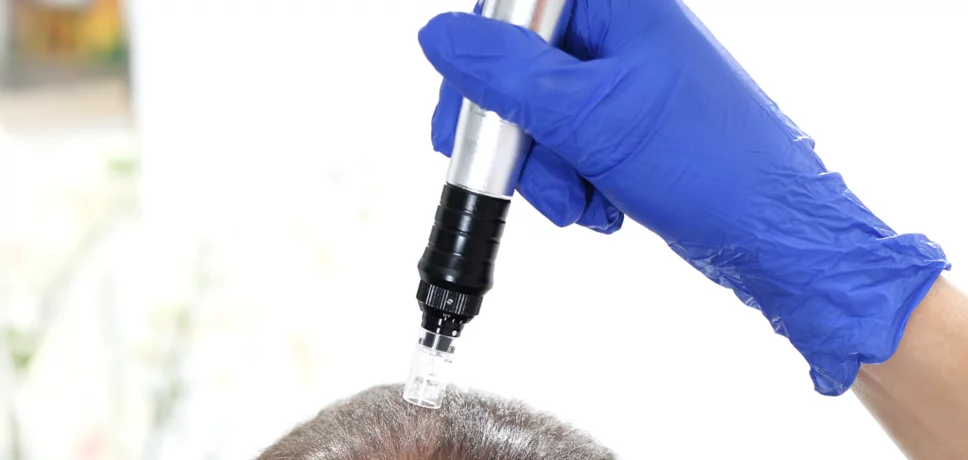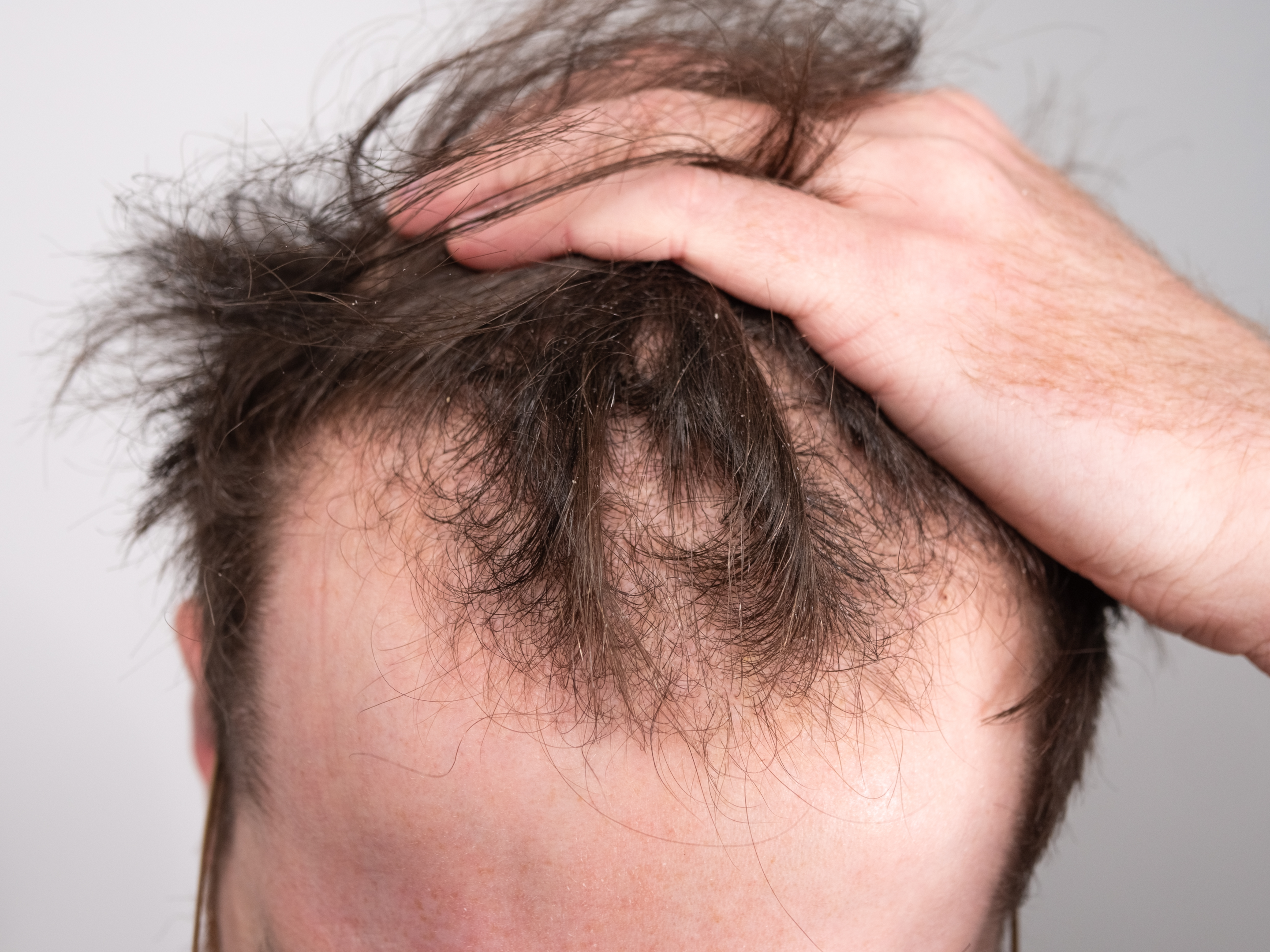
“What doesn’t kill you makes you stronger”- and your scalp seems to be no exception.
Androgenetic alopecia (AGA) – or male pattern baldness (MPB) – is the most common cause of male hair loss, responsible for 95% of hair loss cases. While there are evidence-based treatment options like Finasteride and Minoxidil (aka Rogaine) that can stop and even reverse hair loss in the majority of men, they don’t work for everyone.

But gone are the days of simply accepting your fate, trying risky unlicensed treatments or going straight for costly hair transplant surgery. New treatments are entering the fray, and one such treatment, microneedling, has grown in popularity.
Read on for more information about microneedling treatments including:
- What is microneedling?
- How can microneedling stimulate hair growth?
- What happens in a microneedling session?
- When can you expect to see positive results of hair regrowth?
What is microneedling for hair loss?
Microneedling is a cosmetic procedure where a device is used to make micro punctures in the scalp using lots of tiny needles. These needle marks- which can vary from 0.5 to over 2mm in depth- can promote hair growth in a few different ways.
Microneedling has been used for a while as a treatment for skin conditions like acne scarring, wrinkles and pigmentation, sometimes under the alternative name of “collagen induction therapy” due to its effects on collagen production. But hair loss experts discovered that the underlying repair process could also be applied to the scalp for hair loss. Microneedling is now growing in popularity as a method for stimulating hair growth, promoting healthier hair and ultimately treating hair loss.
How does microneedling promote hair growth?
Microneedling devices use lots of tiny needles to puncture the scalp, creating tiny wounds over the area of the scalp where thinning has begun. This starts a healing process that increases blood flow to the hair follicles to boost scalp health. It also causes the release of growth factors and stimulates scalp stem cells to “wake up” dormant hair follicles and promote hair growth.
Microneedling treatment also increases the absorption of topical treatments by creating lots of mini-channels in the scalp. A combination of microneedling with adjuvant treatment, such as topical minoxidil, can work better in promoting hair growth and treating hair loss.
Does microneedling promote hair growth?
The short answer is yes! When performed properly (ideally by a professional), microneedling can be an effective hair growth treatment in MPB sufferers, as well as those with rarer causes of hair loss such as alopecia areata and telogen effluvium.
Early research using mice has since been repeated in humans, such as a landmark 2013 study that compared weekly microneedling plus Minoxidil with just Minoxidil therapy. At the end of 12 weeks, the microneedling group had over four times the hair count when compared to the minoxidil-only group. Notably, the combination also helped participants who had previously found no benefit from Minoxidil and Finasteride therapy.
Since then, several more studies have looked at microneedling as a treatment for MPB.
One recent review of the research found microneedling to be beneficial as a standalone treatment for MPB, even more so than topical minoxidil- one of the most popular treatments that exist. However, the most powerful effect was seen when the two were combined. The combination of microneedling with a topical medication was also supported by a large 2022 review, which also found that microneedling helped patients whose hair loss had plateaued on other treatments.
Microneedling has also been shown to promote hair growth in alopecia areata and female pattern hair loss.
Whilst there is plenty of reason to be excited, it’s worth noting that microneedling for hair loss is a relatively new topic so we still need more large research studies on it. In particular, current studies are quite inconsistent in things like microneedling techniques, needle depth and how regularly treatments are given to study participants.
How is microneedling for hair loss done?
Microneedling is a “minimally invasive” procedure, which means it is technically a surgical procedure but one with very fast recovery times and only a small amount of bleeding. This is because the needles only penetrate the upper layers of the scalp.
Microneedling treatments begin with applying local anaesthetic to numb the scalp and minimise pain. After around 30 minutes, the procedure can begin.
A clean microneedling device is then used to make micro punctures over the areas where hair thinning has begun. While some clinics may use a dermaroller (aka skin roller), most will use a microneedle pen as you can get more accurate vertical needle marks, minimising damage to existing hair follicles.

The whole process can take as little as thirty minutes- not bad for a surgical procedure! This will depend on the size of the scalp area being treated and the device used.
Post-treatment care
Immediately after the microneedling treatment your scalp will likely be red and sore so make sure to keep the area clean and steer clear of the tight-fitting caps. Your scalp can also be extra sensitive to sunlight for a few days, so it’s a good idea to avoid direct sunlight and apply sunscreen. You may also be given balms or antibiotics to use on your scalp in the days following your treatment.
Make sure to follow any aftercare instructions given by your clinic and refer to your healthcare provider if you have any questions.
What are the risks of microneedling for hair loss?
Even though it is minimally invasive, there are still some risks to be aware of with microneedling. Most people will experience some level of redness, discomfort and swelling from the wound areas on the scalp. Because of this scalp sensitivity, avoiding direct sunlight for a day or two after the procedure is often advised. If not cleaned properly, there’s also a risk of infection.
There is also a small risk of scarring, particularly when using a dermaroller device because the needles can enter at an angle, causing a “tearing” effect on the scalp. This can also cause excessive hair shedding by damaging hair follicles- not the result you want!
Some people may experience allergic reactions to local anaesthetic agents, so it’s worth speaking to your healthcare professional before you undergo treatment. According to the British College of Aesthetic Medicine, you should also mention if you have any scarring conditions, take blood thinners or have any existing medical conditions as this might affect whether they are happy to go ahead with the procedure.
Overall, microneedling is a low-risk procedure and serious reported side effects are rare.
Microneedling for hair loss FAQs
What is the best depth for scalp microneedling?
There isn’t currently a definite answer for this because scalp thickness differs between people. Generally, shorter needles produce less pain but also have more limited effects, which is why professional-grade microneedling devices are usually longer (>1mm). It’s also worth noting that scalp thinning happens naturally over time (especially if you suffer from MPB) so the needle length will need to be reduced over time anyway.
Microneedling sessions should start with a shorter needle length that produces minimal bleeding over the treatment area. Ultimately, shorter needles will be safer and produce less pain and bleeding but if they’re too short then you’ll be limiting the results.
How often should I use microneedling treatment?
Inresearch studies, the frequency of microneedling treatment for hair loss ranges from weekly microneedling sessions up to around once every two months. As a general rule, you must allow enough time for wound healing between treatments to reduce the risk of scarring. For most people, a weekly microneedling procedure would be too much to begin with but might be possible after getting used to the treatments.
How long does it take to see hair regrowth from microneedling?
It can take anywhere from several weeks to a few months to properly see results. Ultimately, you are triggering a healing process that takes time to ramp up. Adding in another treatment such as Minoxidil or Finasteride can help to speed the process up.
Can I do microneedling at home?
Whilst it is possible to buy at-home microneedling devices, it’s best to consult a professional. At-home devices are generally on the shorter end (less than 0.5mm) which may limit results and the lack of professional oversight may increase the risk of infection and scarring.
At-home microneedling devices are usually dermarollers which can cause damage to the hair shaft, affecting hair density and potentially worsening hair loss!
Should microneedling be used with other treatments?
Studies have found an added benefit when combining microneedling with an adjuvant treatment such as topical Finasteride or Minoxidil. This is probably because the microneedling procedure creates lots of tiny channels in the scalp for better absorption of topical medications.
It’s worth using your scalp treatment on a different day than the microneedling therapy to reduce the risk of irritation. This also prevents topical treatments from building up in the bloodstream which can increase the risk of side effects.
Microneedling can be combined with:
- Topical minoxidil lotion
- Topical finasteride
- Platelet-rich plasma
Key takeaways
Microneedling is a safe and effective treatment option to regrow hair in people suffering from hair loss. While we still need more research to narrow down the specifics, the combination of microneedling with topical medication is a promising option for people with thinning hair and a receding hairline that hasn’t responded to conventional therapy. It’s best to explore microneedling under the care of a professional who can offer tailored treatment and advice.
While we’ve ensured that everything you read on the Health Centre is medically reviewed and approved, the information presented here is not intended to be a substitute for professional medical advice, diagnosis, or treatment. It should never be relied upon for specific medical advice. If you have any questions or concerns, please talk to your doctor.
While we've ensured that everything you read on the Health Centre is medically reviewed and approved, information presented here is not intended to be a substitute for professional medical advice, diagnosis, or treatment. It should never be relied upon for specific medical advice. If you have any questions or concerns, please talk to your doctor.





